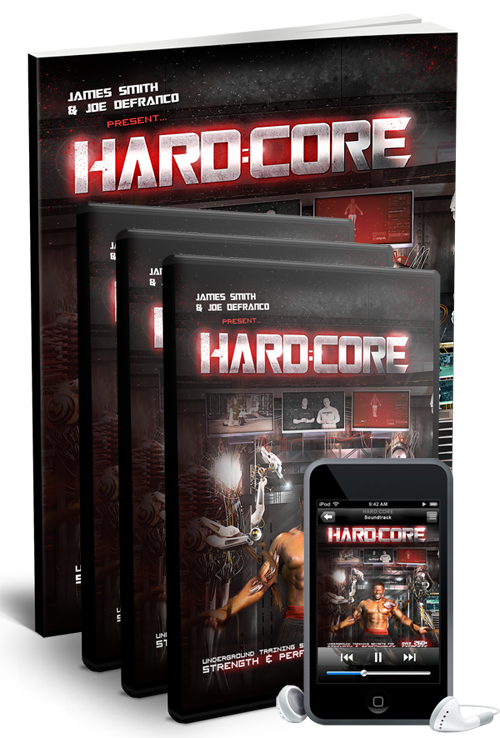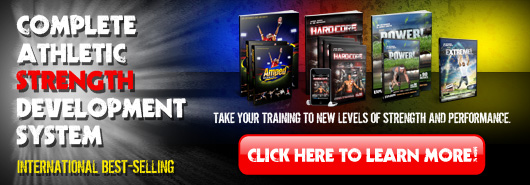New HardCORE Core Development System
New Hard:CORE Core Development System
The new Hard:CORE Core Development System is LIVE!!
To celebrate the release of this new awesome product, I dropped the hammer on 10 common core training myths. Check them out below!
Before we get into the myths, I wanted to tell you about a Facebook contest Joe DeFranco and I are running.

Joe D. and I are putting together a special contest on Facebook and it is super simple to enter. To be entered for a chance to win the contest all you have to do is purchase the new Hard:CORE system and once it arrives, take a picture and post it on Facebook. Once you post the picture, just “tag the photo” with “Defranco’s Gym” and “James Smith.”
Simple, right?
We will announce the 3 winners on both our sites on July 7th, 2012.
Myth #1: Core strength is NOT about crunches!
The muscle groups that stabilize, protect the spine and engage movements of the torso do not act in isolation, so why engage in exercises that attempt to target only a few muscle groups that make up the core? Crunches have other issues as well. Too many crunches can shorten the depress the rib cage, which will affect your posture and breathing – if you don’t have a good holistic training program. Isolative core exercises can be incorporated into your program but they are only ONE part of a more comprehensive strategy.
Myth #2: Core strength is NOT about wobble boards!
Yes, wobble boards do have their place in a rehabilitative setting where a patient needs to reengage stabilizing muscles or re-establish balance and proprioception after an injury. They can also be used to develop shoulder and core stability by having the athlete setup in a push-up or plank position with their hands, elbows or feet on the wobble board. But, standing on a wobble board isn’t an effective training means as some coaches might have you believe. There is an inverse relationship between the stability of the base support and the power potential of the lifter or athlete.
Myth #3: Core strength is NOT only about strengthening in patterned movements!
Sport is not patterned and life is not patterned. The fairy tale environment that happens in the gym does not happen in the real world. You can’t set your breath, keep your spine in neutral and execute a perfect cadenced tempo for an exercise with each and every repetition. You must introduce ‘chaotic’ movements, in addition to conventional core training. This will provide the athlete with a comprehensive core strength profile. Loaded carries such as zercher sandbag carries, sled dragging variations, or various kettlebell carries, create a non-optimal environment that the athlete has to overcome to remain in a good position. This, in addition to conventional core exercises, will develop more ‘real world’ adaptations and powerful core strength.
Myth #4: Core strength is NOT ONLY about moving your own bodyweight!
As you move, your body adjusts and adapts. Once your body becomes accustomed to these movements, there is no more adaptation. The engaged musculature must be constantly challenged if you want to continue to make progress. This holds true for the muscles that surround, support and stabilize your core, i.e., the superficial outer core. The S.A.I.D. Principle and the Principle of Progressive Overload state that muscles adapt to imposed demands and that you must continually push yourself so that you don’t hit a training plateau. Adding resistance to your core training exercises and pushing yourself on your main compound lifts will continue to build next level core strength.
Myth #5: Core strength is NOT only about slow movements!
Life is not about slow movements. Life and sport are explosive and you must train the core to transfer forces efficiently. You must incorporate more dynamic movements to supplement your workout. Exercises such as medicine ball throws, elastic band snap downs or kettlebell swings are just a few examples how your can train explosively, reinforce good positioning and develop core stability.
Myth #6: Core strength is NOT possible without attention to breathing!
Regulating your breathing patterns plays an important role in stabilizing the torso during any type of movement. By engaging optimal intra-abdominal pressure we can establish proper tension for any movement. Also, utilizing the deep-lying breathing muscles synergistically and isometrically contracting the muscles that surround the torso, we can maintain proper torso rigidity and stay safe. This is the essence of “bracing.” As you move, force is transferred across the kinetic chain, and dependent upon your or your athletes’ ability to sustain proper bracing, the force is either transferred efficiently or dissipated. This is very important for any sport that requires fast and powerful movements, i.e., ALL sports.
Myth #7: Core strength is NOT only about the muscles you can see!
If you are just working on your “six pack abs” or trying to target the superficial ‘outer core’ (rectus abdominus, transverse abdominus, external and internal obliques) in your core training strategies, you are missing other very important components. Proper breathing, good posture and developing the posterior chain are the other missing pieces of the puzzle.
Myth #8: Core strength is NOT about doing high volume sets!
”I do 300 crunches, 400 crunches, 1000 crunches a day, to maintain my six pack!” Realistically, if you want a “six pack”, you need to be hyper-focused on your nutrition. And if you want core strength, you need to build up the core musculature comprehensively, i.e., both the anterior chain and the posterior chain with compound exercises. Let me ask you a question. If you can do 300, 400 or 1000 crunches, how hard can they be? You should focus on good quality exercises executed with proper form and focus on tension throughout the movement. This means a core-specific movements or compound movements should be incorporated with control (proper bracing) through the entire range of motion. Explosive core movements, such as medicine ball throws, can then be added once the athlete has shown proficiency with the basic movement patterns.
Myth #9: Core strength is NOT developed by always wearing a belt!
Belts are a great tool. A great tool to make you weak! Belts should only be used when needed, not all of the time. If you are teaching young athletes how to brace, a loose belt (even an elastic band – see the Hard:CORE system) is a good tactile tool to help them learn how to brace 3-dimensionally outward. But don’t wear a belt all of the time in the gym, because it will make you weaker. You won’t have to use your ‘natural belt’ or core for less than maximal efforts. If you are loading above 85%+ of the lifter or athlete’s one rep max (referred to as 1RM), a belt can then be used. Note: The 1RM is the absolute or total amount the lifter can lift in the respective exercise.
Myth #10: Core strength is NOT about “six pack abs!”
As stated, just because you’re ripped or shredded doesn’t mean anything when it comes to core strength. A ripped core only speaks to your current level of percentage of body fat. Having a strong core means that you are able to demonstrate stability across the torso when you move. Or more specifically, you can maintain proper positioning and bracing when your extremities (arms and legs) are in motion for any activity.
By Smitty on June 12th, 2012
FREE DIESEL NEWSLETTER
- Discover Pain Free, Joint-Friendly Training
- Get Super Effective Workouts and Programs
- Inspirational Life Lessons Each Week
- Effective Habits For Busy Entrepreneurs
















Just bought Hard Core and can’t wait. You always have top quality information products and great customer service. Keep it up, love it.
I’d wish you luck on your latest product but excellent stuff sells itself. Can’t wait to receive this. Hope all is well.
I had a trainer who refused to talk about “core” or “abdominal” exercises for reasons you list in these myths. Instead, we decided on the word TRUNK: like a tree’s trunk, our cores go all the way around our bodies. As well, trees do not care about “six packs.”
I have a lower back that is shot to pieces. A strong core basically keeps it in check. If I slack off on working my core muscles then my back will soon tell me if I am letting things slip. I can’t tell you how much a strong core will help if you suffer from back problems.
Years ago a very fit friend of mine told me that your body’s athletic ability is derived from basically just below your chest to just above your knees. It looks good to have big arms and a big chest, but if you want to be “strong” then work on everything in that area. You will walk around feeling like you are wearing an Iron Man suit.
As a ratio of my overall workout I hardly spend any time on crunches.
This looks like a ‘game changer’ like you said. Can’t wait to get my hands on it and use it with my athletes. Keep it up guys! Your stuff is awesome!